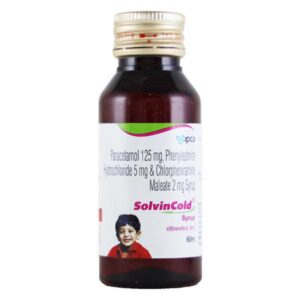PARACETAMOL + PHENYLEPHRINE + CHLORPHENIRAMINE
Paracetamol: Paracetamol, also known as acetaminophen, is a medication used primarily for the treatment of pain and fever. It belongs to the class of drugs called analgesics (pain relievers) and antipyretics (fever reducers). Paracetamol can be taken orally in the form of tablets or capsules, or be administered intravenously in hospital settings.
The exact mechanism of action of paracetamol is not fully understood, but it is believed to work by inhibiting the synthesis of prostaglandins, which are chemicals that contribute to pain and fever. By blocking the production of prostaglandins, paracetamol helps reduce pain and lower body temperature.
The recommended dose of paracetamol varies depending on age, weight, and the severity of the condition being treated. For adults and children 12 years and older, the usual dose is 325-1000 mg every 4-6 hours, with a maximum daily dose of 4000 mg. However, it is important to read and follow the instructions on the packaging or consult a healthcare professional for appropriate dosing.
While generally considered safe when used at recommended doses, paracetamol may cause side effects in some individuals. Common side effects include nausea, vomiting, stomach pain, and allergic reactions such as rash or itching. In rare cases, paracetamol can cause serious liver damage, especially when taken in excessive doses or in combination with alcohol. Therefore, it is crucial to avoid exceeding the recommended dosage and to consult a healthcare professional if symptoms persist or worsen.
Paracetamol is widely available over-the-counter and is commonly used for the management of mild to moderate pain and fever associated with various conditions such as headaches, muscle aches, colds, and flu. However, it is important to note that paracetamol is not effective for reducing inflammation and should not be used for conditions such as arthritis. If you have any concerns or questions about using paracetamol, it is recommended to consult a healthcare professional.
Phenylephrine: Phenylephrine is a medication that is used to treat nasal congestion, sinus congestion, and ear congestion caused by the common cold, allergies, or other respiratory illnesses. It is a decongestant that works by narrowing the blood vessels in the nasal passages, which helps to relieve congestion and improve breathing.
The main mechanism of action of phenylephrine is through its activity as an alpha-1 adrenergic agonist. By stimulating alpha-1 adrenergic receptors, it causes contraction of the blood vessels, reducing blood flow and congestion in the nasal passages.
The usual dose of phenylephrine for adults and children over 12 years old is 2 to 4 tablets or capsules (10 mg each) every 4 hours, with a maximum dose of 4 doses (40 mg) in 24 hours. For children under 12 years old, the dose should be determined by a doctor based on the child’s weight and age. Phenylephrine is typically taken orally in tablet or capsule form, but it can also be available as a syrup or nasal spray.
As with any medication, there can be side effects. Common side effects of phenylephrine may include increased heart rate, increased blood pressure, headache, dizziness, nervousness, nausea, and difficulty sleeping. Some individuals may also experience allergic reactions, such as rash or itching. It is important to follow the recommended dose and consult a healthcare professional if any concerning side effects occur. People with certain medical conditions, such as heart disease, high blood pressure, diabetes, or thyroid problems, should consult their doctor before using phenylephrine.
It is worth noting that while phenylephrine can provide temporary relief from congestion, it does not treat the underlying cause of the congestion, such as a cold or allergies. It is important to consult a healthcare professional if symptoms persist or worsen.
Chlorpheniramine: Chlorpheniramine is an antihistamine medication used to relieve symptoms of allergic conditions such as hay fever, allergic rhinitis, and urticaria (hives). It works by blocking the effects of histamine, a substance produced by the body in response to allergens, which causes symptoms like itching, sneezing, runny nose, and watery eyes.
The drug is available in various forms including tablets, capsules, syrups, and as an injectable solution. The usual adult dose of chlorpheniramine is 4 mg every 4 to 6 hours, while the usual pediatric dose is 0.1 mg/kg of body weight per dose, also every 4 to 6 hours. However, the specific dosage may vary depending on the individual’s age, condition, and response to treatment, so it’s important to consult a healthcare professional for the appropriate dose.
Common side effects of chlorpheniramine include drowsiness, dry mouth, blurred vision, constipation, and urinary retention. These side effects are usually mild and may diminish over time. However, caution should be exercised when performing activities that require mental alertness, such as driving or operating machinery, as the drug may cause drowsiness.
Some people may experience more serious side effects like fast or irregular heartbeat, difficulty urinating, or severe dizziness. If any of these occur, it is important to seek medical attention immediately.
Chlorpheniramine may also interact with certain medications, such as sedatives, tranquilizers, and other antihistamines, so it is essential to inform your healthcare provider about all the medications you are taking to avoid potential drug interactions.
Overall, Chlorpheniramine is an effective medication for relieving allergy symptoms, but it should be used as directed and in consultation with a healthcare professional to ensure safe and appropriate use.

